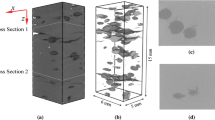Abstract
This work describes the relationships observed between the porosity of fired ceramic test pieces and the raw materials contents in the unfired mixture. The investigation was carried out using the mixture experiments design approach coupled with response surface methodology, which enables the calculation of statistically significant models for the properties from a limited number of experimental results. Ten formulations of a clay mixture, potash feldspar and quartz sand were processed in the laboratory under fixed conditions, similar to those used on wall and floor tile industrial practice, and characterized. Closed porosity (CP) was estimated from the analysis of back-scattered SEM photomicrographs, open porosity (OP) was calculated as the product of bulk density and water absorption, and total porosity (TP) was calculated from OP and CP values. Characterization results were used to calculate statistically significant and valid regression equations, relating those properties with the raw material contents in the unfired mixture. For the particular raw materials and processing conditions used, the models clearly show how quartz contributes to increasing OP and the crucial role played by feldspar when CP and TP are to be minimized (circa 3 vol.%), and how the clay content can counteract that effect and lead to maximum closed porosity (∼14 vol.%).





Similar content being viewed by others
References
Myers RH, Montgomery DC (2002) Response surface methodology: process and product optimization using designed experiments. John Wiley & Sons, New York
Cornell JA (2002) Experiments with mixtures: designs, models and the analysis of mixture data, 3rd edn. John Wiley & Sons
Reed JS (1998) Introduction to the principles of ceramics processing, 2nd edn. John Wiley & Sons, p 395
Amoros Albaro JL, Blasco Fuentes A, Enrique Navarro JE, Negre Medall F, Manfredini T, Pozzi P (1990) Ind Ceram 10:73
Correia SL, Curto KAS, Hotza D, Segadães AM (2004) J Eur Ceram Soc 24:2813
Correia SL, Hotza D, Segadães AM (2005) CFI—Ceram Forum Int 82:E39
Correia SL, Novaes APN, Hotza D, Segadães AM (2006) J Am Ceram Soc 89:3356
Carty WM, Senapati U (1998) J Am Ceram Soc 81:3
Appoloni CR, Fernandes CP, Innocentin MDM, Macedo A (2004) Mater Res 7:557
Manfredini T, Pellacani GC, Romagnoli M (1995) Am Ceram Soc Bull 74:76
Ece OI, Nakagawa ZE (2002) Ceram Int 28:131
Stathis G, Ekonomakou A, Stournaras CJ, Ftikos C (2004) J Eur Ceram Soc 24:2357
Khalfaoui A, Kacim S, Hajjaji M (2006) J Eur Ceram Soc 26:161
Maiti KN, Kumar S (1992) Ceram Int 18:403
Tucci A, Esposito L, Rastelli E, Palmonari C, Rambaldi E (2004) J Eur Ceram Soc 24:83
Acknowledgements
The authors appreciate the financial support received from the Brazilian Research Agency CAPES in the form of a Ph.D. grant (S.L. Correia), and are thankful to Colorminas for providing the raw materials used throughout the work.
Author information
Authors and Affiliations
Corresponding author
Rights and permissions
About this article
Cite this article
Correia, S.L., Hotza, D. & Segadães, A.M. Predicting porosity content in triaxial porcelain bodies as a function of raw materials contents. J Mater Sci 43, 696–701 (2008). https://doi.org/10.1007/s10853-007-2188-3
Received:
Accepted:
Published:
Issue Date:
DOI: https://doi.org/10.1007/s10853-007-2188-3




